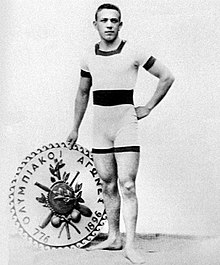History of swimming
In January 2023, the name was changed from FINA to World Aquatics[1] Rock paintings of people with their arms and legs contorted in a swimming position were found by explorer László Almásy in a remote cave in Wadi Sura, in the south of the Gilf Kebir Plateau, Egypt.
[2] More references to swimming are found in the Babylonian and Assyrian wall drawings, depicting a variant of the breaststroke.
Depictions of swimmers have also been found from the Hittites, Minoans and other Middle Eastern civilizations, in the Tepantitla compound at Teotihuacan, and in mosaics in Pompeii.
Such references occur in works like Gilgamesh, the Iliad, the Odyssey, the Bible (Ezekiel 47:5, Acts 27:42, Isaiah 25:11), Beowulf, and other sagas, although the style is never described.
A series of reliefs from 850 BC in the Nimrud Gallery of the British Museum shows swimmers, mostly in a military context, often using swimming aids.
The Talmud, a compendium of Jewish law written compiled c. 500 CE, requires fathers to teach their sons how to swim.
In 1538, Nikolaus Wynmann, a Swiss–German professor of languages, wrote the earliest known complete book about swimming, Colymbetes, sive de arte natandi dialogus et festivus et iucundus lectu (The Swimmer, or A Dialogue on the Art of Swimming and Joyful and Pleasant to Read).
The book contained a good methodical approach to learning breaststroke, and mentioned swimming aids such as air-filled cow bladders, reed bundles, and cork belts.
His short treatise, De arte natandi, was written in Latin and contained over 40 woodcut illustrations depicting various methods of swimming, including the breaststroke, backstroke and crawl.
[12] In 1793, GutsMuths from Schnepfenthal, Germany, wrote Gymnastik für die Jugend ("Exercise for youth"), including a significant portion about swimming.
The sport grew in popularity and by 1880, when the first national governing body, the Amateur Swimming Association, was formed, there were already over 300 regional clubs in operation across the country.
The winning medal went to 'Flying Gull' who swam the 130-foot length in 30 seconds – the Native American swimming method proved to be a much faster style than the British breaststroke.
The Times of London reported disapprovingly that the Native American stroke was an unrefined motion with the arms "like a windmill" and the chaotic and unregulated kicking of the legs.
The considerable splashing that the stroke caused was deemed to be barbaric and "un-European" to the British gentlemen, who preferred to keep their heads over the water.
The British did, however, adapt the breaststroke into the speedier sidestroke, where the swimmer lies to one side; this became the more popular choice by the late 1840s.
[13] Sir John Arthur Trudgen picked up the hand-over stroke from South American natives he observed swimming on a trip to Buenos Aires.
In 1908, the world swimming association Fédération Internationale de Natation Amateur (FINA) was formed.
At these games Duke Kahanamoku from Hawaii won the 100 m freestyle, having learned the six kicks per cycle front crawl from older natives of his island.
The Deutsche Lebens-Rettungs-Gesellschaft (DLRG) (German lifesaving organization) was established on October 19, 1913 in Leipzig after 17 people drowned while trying to board the cruise steamer Kronprinz Wilhelm.
At the 1924 Summer Olympics in Paris, lane dividers made of cork were used for the first time, and lines on the pool bottom aided with orientation.
The scientific study of swimming began in 1928 with David Armbruster, a coach at the University of Iowa, who filmed swimmers underwater.
[citation needed] The Japanese also used underwater photography to research the stroke mechanics, and subsequently dominated the 1932 Summer Olympics.
Armbruster also researched a problem of breaststroke where the swimmer was slowed down significantly while bringing the arms forward underwater.
Previously, the arms were held straight during the underwater push phase, for example by the top backstroke swimmer from 1935 to 1945, Adolph Kiefer.
However, Australian swimmers developed a technique where the arms are bent underwater, increasing the horizontal push and the resulting speed and reducing the wasted force upward and sideways.
Shortly afterwards the bikini was invented in Paris by Louis Reard (officially) or Jacques Heim (earlier, but slightly larger).
This led to a controversy at the 1956 Summer Olympics in Melbourne, and six swimmers were disqualified as they repeatedly swam long distances underwater between surfacing to breathe.
The adoption of this technique led to many swimmers suffering from oxygen starvation or even some swimmers passing out during the race due to a lack of air, and a new breaststroke rule was introduced by FINA, additionally limiting the distance that can be swum underwater after the start and every turn, and requiring the head to break the surface every cycle.
The swimmers Daichi Suzuki (Japan) and David Berkoff (America) used this for the 100 meter backstroke at the 1988 Summer Olympics in Seoul.
Sophisticated bodyskins were banned from FINA competitions from the start of 2010 after many national swimming federations demanded the action, and leading athletes such as Michael Phelps and Rebecca Adlington criticized the suits.








